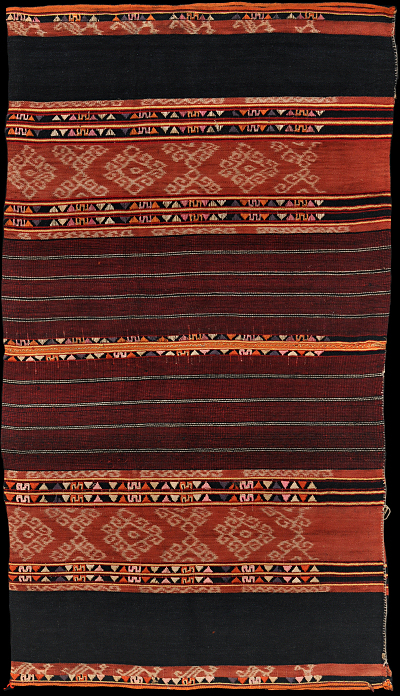| |
 
 | | | |
268 Moluccas, Wetar
Sarong 
| | Locale: | Cloth was collected on Wetar, where ikat died out around 1850, but which has close relations with the courts of Timor and Savu, Raijua. Cloth probably made on Babar or Tanimbar. If on Tanimbar, then probably on Larat. | | Period: | Early 20th C. | | Yarn: | Cotton, hand-spun, fine - plus unknown fibre, possibly lontar. | | Technique: | Warp ikat, discontinuous supplementary weft. | | Panels: | 2 | | Size: | 65 x 119 cm (2' 1" x 3' 10") LW: 1.83 | | Design: | Main ikated bands, done in ecru on morinda, several other narrow ikated bands in the same tones, alternated with plain bands decorated in snakes and triangles executed in discontinuous supplementary weft, a type of decoration in the Tanimbar repertoire. Yarn used here appears to be silk. Overall look, with a three-fold repeat of the main motif in ecru on warm morinda red and striped midfields, is similar to that seen on Raijua, and the overall design is similar to one Raijua sarong in this collection, PC 104 and to one in the Georges Breguet collection, but the visual 'feel' is different from anything made on Raijua. The discontinuous supplementary weft is in the Tanimbar repertoire, as also in that of Timor. The ikated bands at top and bottom show birds with long plumes, probably cocks, a motif seen on Babar, Tanimbar, Luang, Kisar and also Timor. | | Comment: | Perhaps a gift to a member of the raja's family from another island. Most likely made on Babar or the Tanimbar archipelago, as one would for a woman of the nobility. A lady with the right to have 'ears' on her sarong, i.e. large striking patterns. The design bears a strong likeness to a Raijua style for sacred sarongs, which suggests emulation. It has the same structure of a narrow ikated band at the extremities followed by a wide plain indigo band, then a wide ikated band with a three-fold repeated main motif (here a kaif-like motif strikingly similar to that on our Raijua PC 104) followed by a wide ribbed section made of a fairly hard, glossy fibre other than cotton, probably lontar, possibly abaca. Other style elements, such as the discontinuous supplementary weft and the long-tailed birds, are distinctly un-Raijuan and fit with the Tanimbar vernacular. The colour palette recalls that of the island Larat in the Tanimbars. Ex collection J.B. Lüth. | | Background: | Chapters on Moluccas and Wetar. | | Exhibited: | Hong Kong University Museum and Art Gallery, 2017. | | Published: | HALI 192, 2017.Ikat Textiles of the Indonesian Archipelago, 2018.
| | Compare: | 288 104 105 | | Sources: | No cognates known from literature or on-line museum collections. Please let us know if you find one. The type of main motif, as pointed out by Van Vuuren, is similar to that on old Babar sarongs in Khan Majlis, Indonesische Textilien, Wege zu Goettern und Ahnen, Fig. 558, 567, and 569. The cocks with their bushy tails are similar to those on the circa 1900 Babar sarong on Fig. 569. There is a fair amount of similarity with several more modern sarongs worn by women in a group photo shown in Van Dijk's contribution to Barnes and Hunt Kahlenberg, Five Centuries of Indonesian Textiles, p. 354. There is a close similarity, both in design and applied techniques, to PC 288, tentatively placed in the Babars. | | |

©Peter ten Hoopen, 2025
All rights reserved.
|
|


